Table of contents
- Screwdriver tip on starting problems Troubleshooting guide and solutions
- Fuses
- battery
- Starter system
- Starter itself
- Starter freewheel
- Motor turns, machine does not start
- Checking the fuel system
- Carburetor
- Defective fuel tap
- Cold start system
- Check the ignition
- Defective engine as a cause of starting problems

Ralf Petersen
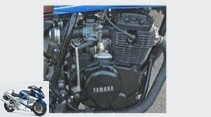



19th pictures
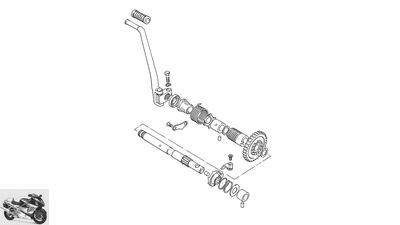
Ralf Petersen
1/19
Starting problems on the motorcycle are tricky. They can occur without warning, whether the engine is cold or warm, on new or old machines.
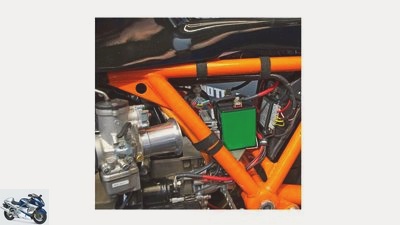
Ralf Petersen
2/19
The main cause of starting problems: a weak battery.
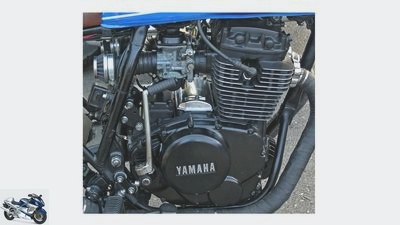
Ralf Petersen
3/19
Good for those who still have one: a Kickstarter is actually priceless.
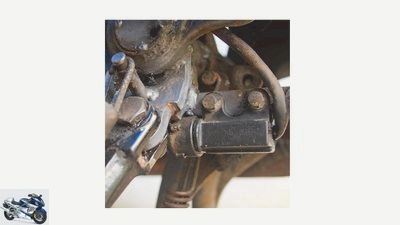
Ralf Petersen
4/19
Bad trap: A dirty / corroded sidestand switch can cause problems.
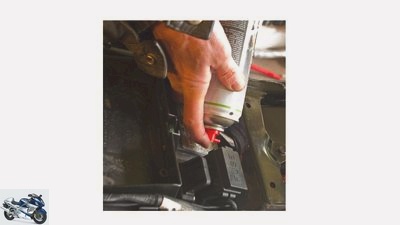
Ralf Petersen
5/19
Sometimes it works: spray start pilot / brake cleaner into the inlet of the air filter box.

Ralf Petersen
6/19
The main components of the starter system: starter, start button, magnetic switch.
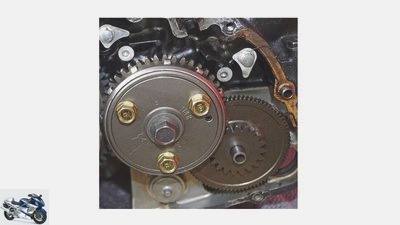
Ralf Petersen
7/19
A defective starter freewheel (here from a VFR 400) can be expensive depending on the model.
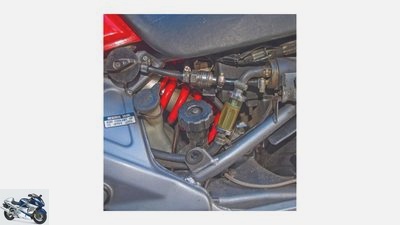
Ralf Petersen
8/19
The main components of the fuel system: fuel tap, lines, filters, pump.
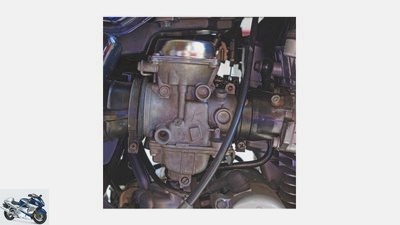
Ralf Petersen
9/19
Usual suspect: The carburetor causes problems, especially after long periods of inactivity.
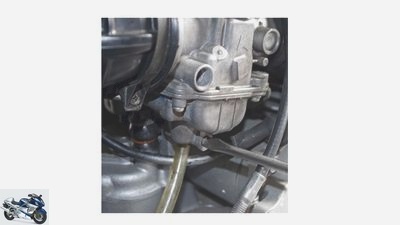
Ralf Petersen
10/19
Prevention is better than pushing: Always empty the float chamber when not in use.

Ralf Petersen
11/19
Faults in the cold start system can cause starting problems when the engine is cold.
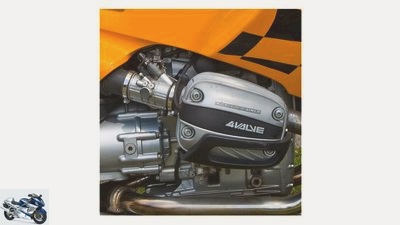
Ralf Petersen
12/19
An injection system is less vulnerable, but more expensive to repair.

Ralf Petersen
13/19
Meaningful: Function test of the plug with an ignition voltage tester.
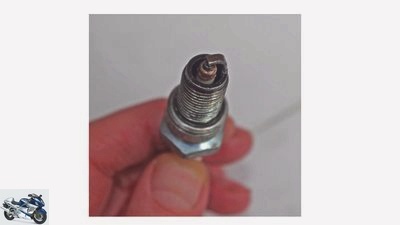
Ralf Petersen
14/19
Drowned: too weak ignition spark or too much fuel. The wet candle smells like fuel.
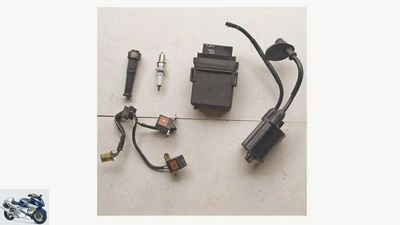
Ralf Petersen
15/19
The most important components of the ignition: ignition box, coils, sensors, spark plugs and plugs.
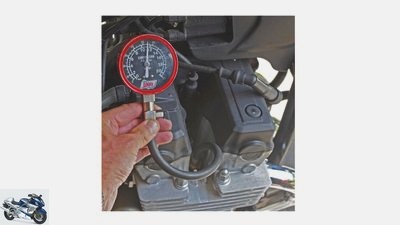
Ralf Petersen
16/19
Not a big challenge: compression testing with a simple measuring device.
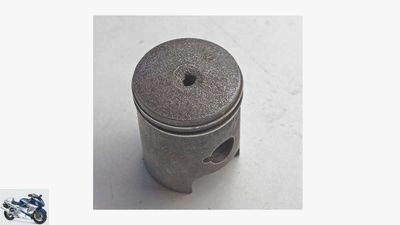
Ralf Petersen
17/19
Worst-case scenario: a hole in the piston results in major engine damage.
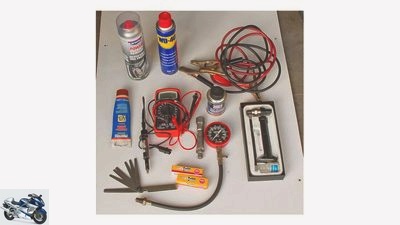
Ralf Petersen
18/19
This is required for maintenance: spark plug wrench, new spark plug, feeler gauge, copper paste, start pilot / brake cleaner, WD 40 or similar, jump start cable, fuel stabilizer, multimeter, ignition voltage tester, compression meter, Colortune candle.
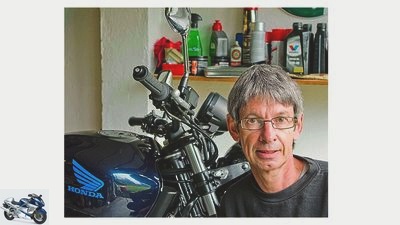
Ralf Petersen
19/19
Ralf Petersen. The author works as a further education teacher at the VHS Duisburg and has been organizing screwdriver courses for 22 years.
counselor
workshop
MOTORCYCLE screwdriver tip on starting problems
Screwdriver tip on starting problems
Troubleshooting guide and solutions
Starting problems on the motorcycle are tricky. They can occur without warning, whether the engine is cold or warm, on new or old machines. Troubleshooting can be time-consuming and difficult because many components interact and can be the cause.
03/03/2021
In this article:
- Fuses
- battery
- Starter system
- Starter itself
- Starter freewheel
- Motor turns, machine does not start
- Check the fuel system
- Carburetor
- Defective fuel tap
- Cold start system
- Check the ignition
- Defective engine as a cause of starting problems
Research into the causes: Every internal combustion engine works according to a relatively simple principle. The fuel is mixed with air, compressed and then ignited. Since the engine has to turn for this, there are four main sources of error for starting problems: the fuel system, the ignition system, starter, etc. as well as the engine and compression area.
Fuses
The first glance always goes to the fuses, which are carefully checked. Another, albeit rare, possibility is a defective ignition lock that can interrupt the power supply. Check that all consumers (lights, indicators and so on) are supplied with power after turning the key. If a starting problem occurs directly or shortly after a handicraft campaign, it is very likely that it is your own fault. Faults during assembly (for example when assembling the tank), disconnected cables, blown fuses or jammed hoses are often responsible for the trouble. But if the motorcycle refuses to work for no apparent reason, it depends on whether the problems arise with a cold or warm engine, sporadically or constantly. It is important to proceed systematically and logically when troubleshooting.
battery
Motor does not turn: In most cases, especially at low temperatures, the problem is caused by the battery. With old machines, quick remedial action can usually be achieved with a courageous step on the kick starter, with motorcycles without a catalytic converter by pushing and with injectors with a catalytic converter by bridging with suitable jump leads. As soon as possible, however, the battery, charging circuit and alternator should be checked using a multimeter. Replacing the battery, regulator or rectifier is relatively unproblematic, while replacing an alternator is more complex and usually considerably more expensive. If the problem is defective or corroded cables or connections or leakage currents, troubleshooting is usually a game of patience.
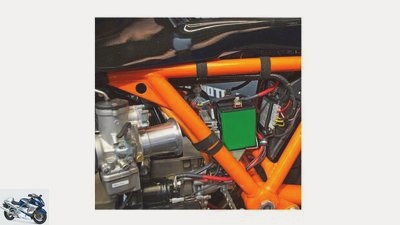
Ralf Petersen
The main cause of starting problems: a weak battery.
Starter system
If the battery and charging circuit are OK, there is probably a defect in the starter system. The simplest mistake is the safety switch on the side stand, which is supposed to prevent driving off with the side stand folded out. It can get stuck due to dirt or corrosion, and the engine cannot be started even though the side stand is folded up. This can be remedied by cleaning and lubrication. Some machines have one “Sidestand”-Control light, thanks to which you can recognize the error immediately.
A starter is usually controlled by a relay, the so-called starter magnetic switch. This relay closes the contact between the battery and the starter after the start button is pressed, and the starter starts working. In rare cases, the fault in the starter switch on the handlebar fitting (often caused by corrosion) or a defect in the corresponding cables. More often, however, it is the magnetic switch itself that is damaged. If it only makes a clacking or rasping noise despite the charged battery, it should be checked. To do this, you can either dismantle the magnetic switch and test it using a resistance measurement in accordance with the instructions in the workshop manual, or bypass it when it is installed. In principle, this is very easy on most machines by briefly bridging the thick screw connections on the magnetic switch using insulated pliers. Alternatively, you can use a motorcycle jump starter cable to connect the positive terminal of the battery to the thick cable leading to the starter or directly to the positive terminal of the starter. Caution: The high starter current can cause violent sparks. If the starter now turns, the magnetic switch is defective and must be replaced.
Starter itself
The next option is the starter itself. To test it, it has to be removed (this is quite easy with many motorcycles) and dismantled. The brush springs, carbon brushes, collector grooves and a possible short to ground of the rotor are checked. Please note the workshop manual! Alternatively, you can take the removed starter to a car electrical workshop (for example Bosch Service), who can sometimes fix the problem for little money. A replacement starter is the last and most expensive option.
Starter freewheel
Damage to the starter freewheel is even more unpleasant and often more expensive. Motorcycles mainly have so-called freewheels as a connection between the starter and the engine, in which the frictional connection is established in one direction via springs and pinch rollers and – as soon as the engine is running – is disconnected again. If this so-called starter clutch is defective, the starting process is usually accompanied by nasty metallic noises, and the starter turns but does not or not always drive the engine. A repair is more or less time-consuming, depending on the design, and not for laypeople. Information and help can usually be found in the corresponding Internet forum for the machine.
Motor turns, machine does not start
The engine turns, but the machine does not start: If the engine is cranked vigorously when starting, at least it is not due to the starter system. If it is only a matter of getting the machine up and running as quickly as possible, Startpilot sometimes helps or, alternatively, simply brake cleaner, which is sprayed into the inlet of the air filter box. This creates a particularly ignitable mixture that makes a cold start easier. Spraying and starting must be done at the same time, if you are lucky, the engine will start. If he does not do this or if the starting problem occurs more frequently, the fault is most likely either in the wrong fuel / air mixture or in the ignition and electrical system.
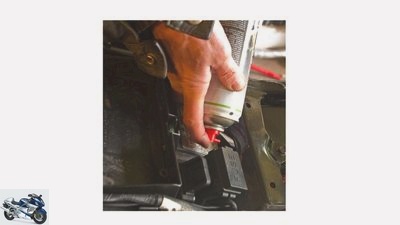
Ralf Petersen
Sometimes it works: spray start pilot / brake cleaner into the inlet of the air filter box.
Checking the fuel system
If so, troubleshooting continues with a fuel system check. This includes the fuel tap, lines, filters and – if available – the fuel pump. Since the gasoline lines are mostly black, it is often not possible to tell whether gasoline is actually reaching the carburetors or the injection system. In the case of carburettor engines, a transparent petrol filter from the accessories, which can be installed behind a petrol pump, can provide clarity in the truest sense of the word. Fuel taps controlled by vacuum (check vacuum hose) and clogged tank ventilation (open tank lid) are also tricky. A completely contaminated or oily air filter can also be the cause of starting problems, because the gasoline / air mixture becomes too rich as a result. A porous or slipped intake manifold, on the other hand, leads to the intake of secondary air, so that the engine runs too lean and usually does not want to start when it is cold.
Carburetor
To the circle of “the usual suspects” With this type of starting problem, the carburetors are the most important. The combustible components of the gasoline evaporate after a long period of time. The remaining fuel is no longer ignitable and the engine will drown when attempting to start. In addition, gumming up old gasoline leads to blockages of the channels or the tiny bores of the nozzles. Therefore you should not forget to let the fuel out of the float chamber in the event of a temporary shutdown. Depending on the accessibility, this is usually possible in a few minutes. If you fail to do this, in the worst case scenario, the carburetor has to be removed and completely cleaned in the ultrasonic bath. Usually, however, it is enough to empty the float chamber and bring the engine back to life with the help of the start pilot.
Defective fuel tap
A defective fuel tap and / or a leaky float needle valve also ensure that too much fuel gets into the system. This is often indicated by a small puddle of gasoline after a short period of time. During the starting process, the insulator of the spark plug center electrode is soaked up with petrol, a leakage current is created, the ignition current is diverted without sparking, and so does the engine”drowns”. To check the float needle valve, the float chamber must be dismantled. If the valve has an annular notch, it should be replaced. Repair kits are available from accessories shops.

Ralf Petersen
The main components of the fuel system: fuel tap, lines, filters, pump.
Cold start system
If the engine only starts with difficulty when it is cold, but starts without problems at operating temperature, the cold start system can logically also be a possible source of error. The choke lever must move easily to the maximum position. If it is only due to jammed trains, the repair is comparatively easy. Occasionally, however, the cause is also contamination or wear and tear in the cold start system itself. Depending on the design, troubleshooting is then considerably more complex.
As a rule, modern machines with injection systems can withstand longer downtimes without complaint. Nevertheless, old gasoline can lead to clogging and gumming and thus cause problems. Fresh fuel with fuel system cleaner usually helps. If not, the entire system has to be cleaned, but it should be left to professionals. Interesting: After disconnecting the battery, the control unit has to be readjusted on some machines. Therefore switch on the ignition and briefly turn the throttle grip two or three times without pressing the starter button.
Check the ignition
If a fault in the fuel system can be ruled out, the ignition must be checked. Due to the very high voltage, working on the ignition is not without risk. It is essential to observe the workshop manual and safety instructions! First you check that all spark plug caps are firmly seated on the plugs, have not loosened and that the ignition cables and spark plug caps have no hairline cracks. To expel any moisture that may be present, spray WD 40 or other penetrating oil into the spark plug cap and, if in doubt, replace the spark plug cap. If that doesn’t help, the spark plugs are checked. If the electrodes are burned round at the edges or if the distance between the electrodes is too great, the plugs are worn out and must be replaced. A quick check of whether an ignition system is still functional is relatively easy to do (even when you are out and about). To do this, the spark plug connector is placed on the removed candle, the metal part of the candle is firmly connected to ground (caution: do not touch it directly with your fingers!) And the electric starter is operated. The spark should be strong and therefore easily recognizable. However, a check with a so-called ignition voltage tester is much more meaningful, which also has the advantage of protecting the sensitive ignition electronics from possible voltage peaks during this test. If the ignition system is intact, the spark should jump a gap of 15 mm.
The candle image also says a lot about possible causes of errors: If the candle is light and dry, it is probably due to the gasoline supply. If, on the other hand, it is brown / sooty and wet, many things point to no or too weak an ignition spark, but possibly also to an excess of fuel and thus a problem with the carburettor.
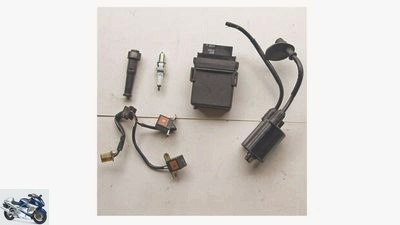
Ralf Petersen
The most important components of the ignition: ignition box, coils, sensors, spark plugs and plugs.
In addition to the plugs and spark plugs, defects in ignition coils, sensors, control units or breaker contacts and of course in the wiring can also be the reason for the problems. In the case of contact ignitions, the contacts and the correct ignition timing are checked both statically and with the aid of an ignition timing gun. If the control unit of an electronic ignition no longer functions properly, this can be determined by taking measurements in accordance with the workshop manual. Such defects are, however, rather rare. A failure of this black box is usually expensive, and with older machines the supply of spare parts is sometimes problematic. Motorcycle workshops specializing in electrics / electronics such as Motek in Bielefeld can then help.
The ignition coils are often located under the tank and consist of primary and secondary windings inside that are potted and cannot be repaired. As long as these windings are intact, an ignition coil will work fine, but if it breaks it must be replaced. With a multimeter and the information in the repair instructions, a resistance measurement can be used to check whether the ignition coil is functional. Unfortunately, ignition coils tend to strike when they warm up and work again when they cool down. This makes troubleshooting a real challenge, as does damage to defective or corroded cabling or the encoders. These are usually located in one of the engine side covers in the immediate vicinity of the crankshaft.
Defective engine as a cause of starting problems
The final cause of the starting problems is still an engine defect, which means that the fuel / air mixture is not compressed enough to be able to ignite. In this case, most hobby mechanics quickly reach their limits, because engine repairs are relatively time-consuming and can hardly be managed by laypeople. A compression test provides the first information about sufficient compression. An inexpensive tester from the accessories trade is sufficient for testing. Since the plugs have to be unscrewed for the compression test, the often heavily soiled plug shaft should be cleaned (e.g. with compressed air) before dismantling so that nothing can fall into the combustion chamber. The measurement must be carried out with the carburetor or throttle valve slides as fully open as possible. If the measurement result (even on just one cylinder) is significantly below the value specified by the manufacturer, there is an urgent need for action.
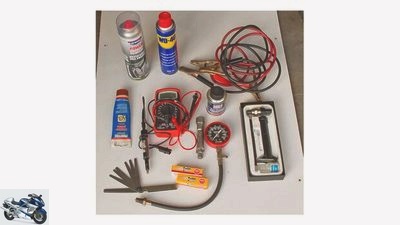
Ralf Petersen
This is required for maintenance: spark plug wrench, new spark plug, feeler gauge, copper paste, start pilot / brake cleaner, WD 40 or similar, jump start cable, fuel stabilizer, multimeter, ignition voltage tester, compression meter, Colortune candle.
The causes of a severe loss of compression can be varied. The cheapest will be the repair of a defective cylinder head gasket. In the case of severely leaking or even burned out valves, not only do the cylinder heads have to be dismantled, but the valves also have to be re-ground or replaced. Depending on the design and access, very different costs arise. The more valves the engine has, the more expensive the overhaul will be.
Fortunately, engine damage such as piston jamming is rare these days. In this case, it is necessary to honed the cylinders and mount oversize pistons. The most curious thing is the hole in the piston, which is feared especially in two-stroke engines and which is caused by overheating. The compression is then of course zero.
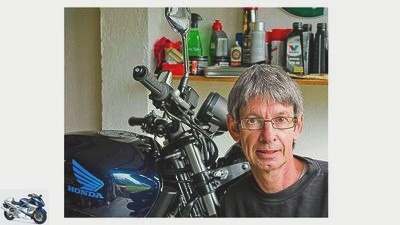
Ralf Petersen
Ralf Petersen. The author works as a further education teacher at the VHS Duisburg and has been organizing mechanics courses for 22 years. 12 to 15 practical seminars on maintenance, repair and technology are offered every year. In 2015, Delius Klasing Verlag published his book “Basiswissen Motorrad-Technik”. Info: www.motorrad-schrauberkurse.de
Since the causes of the starting problems can be very diverse and therefore troubleshooting is not always easy, I often use a Colortune candle for diagnosis. Thanks to the glass bottom in the candle, the color of the burn can be clearly seen. With the help of a diagnostic test tree belonging to the set, the fault can be well localized and then rectified.
Related articles
-
Help with engine problems – When the motorcycle does not run properly
counselor workshop Help with engine problems – When the motorcycle does not run properly Error analysis in case of engine problems 50 reasons your…
-
Screwdriver tips for motorcycle seats
Ralf Petersen 13th pictures Ralf Petersen 1/13 Ralf Petersen 2/13 Ralf Petersen 3/13 Ralf Petersen 4/13 Ralf Petersen 5/13 Ralf Petersen 6/13 Ralf…
-
Screwdriver tip oil change and oil level check
Photo: mps photo studio 14th pictures Honda 1/14 Screwdriver tip – oil change and oil level check. Ralf Petersen 2/14 Preparation: All of this is needed….
-
Motorcycle mechanic tip Alternator and battery
Ralf Petersen 18th pictures Ralf Petersen 1/18 Ralf Petersen explains to us what to look out for with the alternator and battery and how to properly…
-
Screwdriver tip – preparations for the motorcycle vacation tour
Petersen counselor workshop Screwdriver tip – preparations for the motorcycle vacation tour Screwdriver tip – preparations for the motorcycle vacation…
-
Corona slowed motorcycle manufacturers: plants in Europe are starting again
MV Agusta counselor traffic & business Corona slowed motorcycle manufacturers: plants in Europe are starting again Production stop due to measures…
-
Guide: Injection on a motorcycle
Drawing: Schermer counselor technology & future Guide: Injection on a motorcycle Guide: Injection on a motorcycle Find and rectify faults in the…
-
Tips for mechanics: Maintenance of motorcycle cooling systems
Ralf Petersen 15th pictures Ralf Petersen 1/15 We explain how the maintenance of a cooling system works. Ralf Petersen 2/15 This is needed for…
-
MOTORCYCLE screwdriver tips: Repair your motorcycle yourself
Sdun counselor workshop MOTORCYCLE screwdriver tips: Repair your motorcycle yourself Big overview: repair everything to do with motorcycles MOTORCYCLE…
-
Screwdriver tip exhaust system – Honda CB 750 Seven Fifty
Ralf Petersen 14th pictures Ralf Petersen 1/14 The starting point: a Honda CB 750 Sevenfifty for 850 euros, first registration February 1994. Ralf…